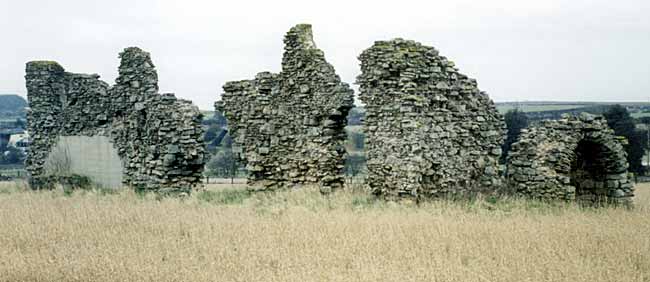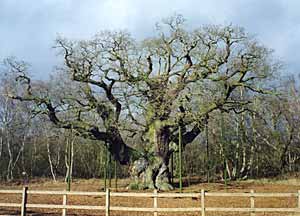
Structual
Standing buildings/ruins
King’s John’s Palace, Kings Clipstone

St John's Palace, Kings Clipstone.
Clipstone was the principal royal hunting lodge in Sherwood Forest. The earliest reference to it appears in the Pipe Rolls for 1164-5 when £20 was spent "on the work of the king’s houses at Clipstone." A deer park was created nearby a few years later which survived until the 19th century.
It was visited by all English kings from Henry II to Richard II and was particularly popular with John and Edward II. The building was ruinous by 1525 and the surviving masonry probably represents chambers and chapels built c.1280 by Edward I.
The remains are "but part of the large complex of high status structures that stood on the site."
- H.M. Colvin, R. Brown, R. Allen and A.J. Taylor, The history of the King's Works Volume II: the Middle Ages (London: HMSO), 1963 p918-21
- J. Wright, , 'A Survey of King John's Palace, King's Clipstone, Nottinghamshire,' Transactions of the Thoroton Society of Nottinghamshire, 108 (2004)
- P. A. Rahtz, , 'King John's Palace, Clipstone,' Transactions of the Thoroton Society of Nottinghamshire, 64 (1960) p21-43
- [A. Stapleton] A History of the Lordship of King's Clipstone, or Clipstone in Sherwood, Nottinghamshire. Repr. from the `Mansfield and North Notts. Advertiser,' September 19th-November 14th, 1890. Mansfield, Linney, 1890 [online version available at the Nottinghamshire History website]
Bestwood Lodge
Construction started on the royal hunting lodge in 1284. Bestwood Park was created later in 1349; the area had previously been described as a ‘hay,’ an area enclosed by a hedge rather than a wooden pale. The Lodge and park were granted by Charles II to his illegitimate son with Nell Gwyn who he made the Duke of St Albans. The lodge was demolished and replaced by the current building, an ornate house in High Victorian style designed by S S Teulon for the Duke of St. Albans, in 1863. Bestwood Lodge is now a hotel.
- T. H Cook, ‘Bestwood Park: hunting down the truth’, Nottinghamshire Historian 15 (1975), 4-6
- D. Crook, The foundation of Bestwood Lodge, 1284, Transactions of the Thoroton Society, 106, (2002), 71-72
- S. Gillett, ‘Bestwood: a Sherwood Forest park in the seventeenth century’, Transactions of the Thoroton Society, 89 (1985), 57-74
- J. T. Godfrey, The History of the Parish and Priory of Lenton, in the County of Nottingham. Bemrose, (1884). `Bestwood Park', [362]-385, ill.
- T. H. Cook, Bestwood Park: Hunting ground of kings, Nottinghamshire Historian 14 (Autumn 1974), 2-5
- R. Rutherford-Moore, Bestwood Park - A Thousand Years of History (2010)
Archaeology
Deer leap, Clipstone Park
Possible medieval deer leap, surviving as a deep linear ditch, but damaged by later quarrying survives in Clipstone parish.
Peel at Clipstone Park
Clipstone Park also contained a defensive timber enclosure (a 'peel') at the western end of the park built by Edward II during 1316-17, although no trace now survives.
- D. Crook, ‘Clipstone Park and ‘Peel,’ Transactions of the Thoroton Society of Nottinghamshire, 80 (1976)
Langton Arbor
Dating from the 1470s this lodge was built to the south-east of Blidworth and appears on a tapestry map of Nottinghamshire (1632) and a plan of Annesley Park published in Robert Thoroton’s History of Nottinghamshire (1677). The Lodge had probably disappeared by the 1690s.
- P. Jones, 'Langton Arbor near Blidworth, Nottinghamshire: A Lost Hunting Lodge in Sherwood Forest'. Transactions of the Thoroton Society of Nottinghamshire, 107 (2003), 104-10.
The Sherwood Forest area encompasses a wide range of archaeological features and built heritage. Consult the Nottinghamshire Historic Environment Record for further information:
Landscape

The Major Oak.
Although much of Sherwood Forest was not wooded, trees and woods were important both for providing cover for deer and other beasts of the chase and also as a source of timber for building. It has been observed that “the chief value of Forests to the king was probably social than economic. They were a source of prestige, of gifts of a kind that money could not buy, and of honorific jobs in the Forest hierarchy.” For example, 50 oaks from Sherwood Forest were gifted to Lincoln Minster in 1252.
The “finest remaining fragments of Sherwood’s ancient woodland” are Birklands and Bilhaugh woods near Edwinstowe which support a substantial population of ‘veteran’ oak trees. The area also contains a Site of Special Scientific Interest and includes the famous ‘Major Oak’ which is estimated to be nearly 1,000 years old.
The oaks of Birklands and Bilhaugh are discussed in the following articles:
- Steven J Clifton, ‘The status of Sherwood’s ancient oaks,’ Transactions of the Thoroton Society, 104 (2000), 51-64
- Steven J Clifton, ‘The veteran trees of Birklands and Bilhaugh, Sherwood Forest, Nottinghamshire,’ English Nature Research Report No. 316 (2000)
- Charles Watkins, ‘A solemn and gloomy umbrage: changing interpretations of the ancient oaks of Sherwood Forest,’ in C. Watkins (ed), European woods and forests: studies in cultural history, 1998, 93-113
A study of the veteran oaks in Welbeck Park was published in 1790:
- Hayman Rooke, Descriptions and Sketches of some Remarkable Oaks, in the Park At Welbeck, in the County of Nottingham, a Seat of His Grace The Duke of Portland. To which are added, observations on the age and durability of that tree. With remarks on the annual growth of the acorn, (1790) [Full text available online at Google Books]
A fascinating article about the failure of woodland management in the 13th century as revealed by dendrochronology is:
- Robert Laxton, A 13th century crisis in the royal forest of Sherwood in Nottinghamshire, Transactions of the Thoroton Society, 101 (1999), 73-98